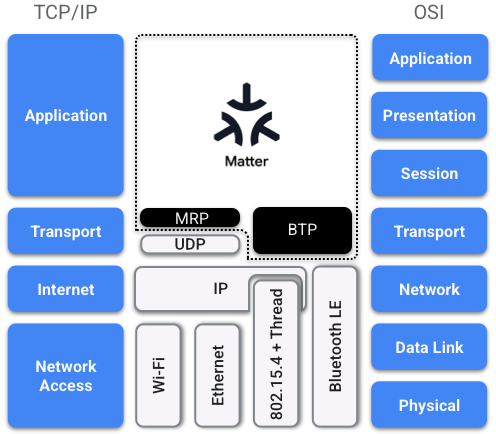Connecting Matter - Part 1
- 3 minutes read - 429 wordsOverview
The Connectivity Standards Alliance just released the Matter 1.2 specification and with that it might be a good start to look into the inner workings of this standard and how things actually work.
Matter tries to unify the Smart Home between all the ecosystems from Apple, Google, Amazon, Samsung and others. If you use one of these ecosystems, then the expierence seems to be unchanged and you are most likely don’t see any difference using a Matter device and hopefully things just work. If you use Linux or are just interested in how technology works, it makes sense to look under the hood and learn some new tricks.
While a lot of companies have announced Matter products or firmware upgrade to existing products, it is a bit of mess out there and trying to navigate on what to buy and how to get started is hard. A small attempt to keep track of devices is done by the German website matter-smarthome. And with that it is good starting point before attempt to by a Matter product for testing.
Architecture
Matter is build around a simple premise of utilizing IPv6 and then using either TCP or MRP (UDP with added reliability) on top of it as transport layer for operational messaging.
An additional transport layer called BTP is used for commissioning over Bluetooth Low Energy (BLE) without using IPv6.
For operational messaging it is possible to use Ethernet, Wi-Fi or Thread (via 802.15.4) in which case it is always via IPv6.
Matter has no need for IPv4 connectivity.

Getting started
Now the question really is how to get started. Since there are no real Ethernet based Matter devices out there, the choice is between a device using Wi-Fi or a device using Thread. Setting up Thread on Linux is another story for another day, I think the best start is to use some Matter over Wi-Fi device.
An interesting fact is that Matter over Wi-Fi device are mainly mains powered and if you want battery powered, you will have to switch to Matter over Thread. This makes sense since operating on battery or even coin cells is something that normally doesn’t work well with Wi-Fi. So for initial testing it seems the target devices will be Smart Plugs or Smart Lightbulbs.
What seems reasonable is the Meross Smart Wi-Fi Plug Mini that can be found at Amazon for less than 20 EUR.
It utilizes Wi-Fi for operational messaging and Bluetooth LE for commissioning.
And best of it, someone else already cracked the device open and looked at its internals.